Chennai (formerly Madras) was hit by epic floods in November 2015. Although the floods were covered extensively by the media at the time not much has been written about them since, at least in English. This is in stark contrast to the Mumbai deluge of 2005 which occasioned a great deal of writing, in the Economic and Political Weekly and elsewhere.
In a time of rapid climate change it is important, I think, to remember the human impacts of serious weather events. Posted below is a first-hand account of the Chennai floods by Manasvini Hariharan. The photographs were contributed by her friends and relatives.

A personal account of the floods by someone who lived through the experience.
Chennai’s second monsoon season, the result of retreating rains from north-eastern India, sees sporadic rainfall in the months of October and November. These yearly rains are a regular occurrence and far exceed the amount of rain produced by the regular monsoon. Ask a school-going child what they think of cyclones and more often than not you will find a smile stretching across their faces as the answer is invariably ‘Rain Holiday!’
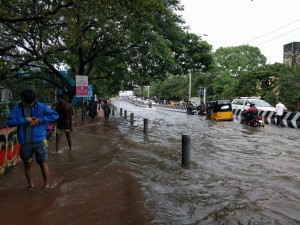
In Chennai, we generally welcome the days preceding a cyclone or depression. It is a respite from the year-round heat that the city experiences. So, when the rain commenced on 9th November, the general response was of relief. Schools and universities were declared closed and it seemed like a standard rain holiday.
However, this time the rain did not cease after its usual one-day spell. Continued downpours over the next days affected low lying areas.
The roads were soon clogged and office-goers were advised to go home. The seriousness of the situation dawned on the citizens, when they heard of the horrible experiences of their friends and family. A friend recounted his scary drive home from work, through a traffic jam in the downpour, when the water slowly started entering the car.

News channels were quick to direct the conversation towards climate change. We read reports about the rain being a result of an El Nino year due to which there was a lesser churning of the Bay of Bengal waters. Since the warm and cool waters did not mix, the surface temperature of the Bay of Bengal was hotter than usual. This, combined with the presence of a monsoon trough close to Chennai, and the effect of easterly waves and winds caused the downpour from the 9th– 16th November.
During the first spell of rains, it was the low lying areas which suffered most. People had to be evacuated from their homes, universities and offices. Despite the grave nature of the state of affairs, people took the entire situation with a pinch of salt. Jokes and light hearted humour about the newest public transport alternative, Ola’s boat option, floated the internet. After a week of uneven rainfall, the waters finally receded. Relief measures were in full swing and slowly the city started to climb back up to stand on its feet.
However, a second spell of rains began on the 29th and it was this spell that devastated the entire city. The roads, still battered from the previous downpour, flooded almost instantaneously. A friend texted saying water had started to enter his house on the ground floor and he had to move upstairs. Another friend despaired over her new car which she could see immersed in the water. We received distress calls from the students in the hostels of the university where I studied, where the water had surpassed ground floor levels.
What set the second spell apart was that it affected every single citizen of the city in some way or the other. Usually, prayers, thoughts and Facebook status messages are sent to the people who face the brunt of the floods. There is no direct relation between the people of the city and those living in low-lying areas. This time, every Chennai-ite’s family and friends were affected by the floods in some way or another which spawned a collective empathy for the entire city.

The situation worsened when it became impossible to leave one’s own neighbourhood. Every area assembled its own relief team to contribute on a micro level. A friend and I went from house to house to collect food and clothing supplies to make relief kits which we succeeded in getting to other parts of the city on 2nd December. On the 3rd, it was impossible for us to meet up with each other within our own neighbourhoods because of flooded roads.
Cell phone connectivity was failing. The airport was flooded. Train service was halted. My very brave mother somehow managed to reach the airport and bring back home an elderly couple who were stranded at the airport. She came back with tales of the chaos that existed beyond our relatively safe locality. People opened up their houses to others who couldn’t get to theirs. Social media was crucial in information exchange and relief efforts. All sorts of requests, calls for help, information and updates were on online platforms. Some tech-savvy citizens quickly created a crowd sourced map indicating flooded roads to avoid. Twitter hashtag #ChennaiRainHelp helped to compile all of the information and requests in one place. The enormity of the disaster dawned on us only when we were well into it.

A friend’s father was recovering from surgery at MIOT hospital, one of Chennai’s biggest hospitals. I received a frantic call from my friend asking about the situation at the hospital as she hadn’t heard from her parents in 24 hours. When she got her mother finally on the phone, it was to hear the story of how the staff had abandoned the hospital leaving patients and their families to fend for themselves. Her epileptic father had not had anything to eat in 12 hours and they were in desperate need of some information of what was happening around them. Arrangements had to be made for critical patients to be airlifted out of the hospital to other nearby hospitals but the others were neglected. Another friend who works at one of those nearby hospitals says he still does not remember how he survived through those 5 days. Hospitals are under-equipped and are not sufficiently prepared for disasters on this scale, he said.
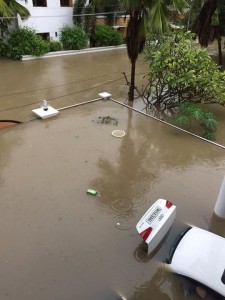
On 1st December, the power supply was cut. Food supplies started running low. The scene at our local markets in the morning was one that I have never seen before. The entire market was wiped clean within 5 minutes of the arrival of food stock. Prices shot up by more than 5 times original rates. The most frustrating part was the inability to help. Many localities were safe from inundation but were also locked off from the rest of the city. Even landline connections died with time, leaving my sister, like many others, with no news of us for 4 days. Completely cut off from the rest of the world, we didn’t know how to filter legitimate information from the rumours that were doing the rounds. We spent day after day for the power to be restored so we could have some news of what really was happening around us.
Through all of this commotion, a friend waded through waist deep water to get to work at the Hindu. The Hindu does not go on leave, he told his worried mother, especially during times like these. Although the office was safe from the floods and had continuous power and internet facilities, their printing press was not so lucky. For the first time in 136 years, the Hindu, on 2nd December, did not go to print.
We spent 5 days with no electricity, water or connectivity. For the first time, families were forced away from their gadgets and towards each other for company. Neighbours whom we never interacted with suddenly became friendly faces. Local vendors, who somehow managed to go in and out of the neighbourhood, were our sources of information. We heard that the road to Bangalore faced a traffic overload, with thousands of people looking to escape to the nearby city. After the 9th, the water began to recede and relief efforts began to gain ground.
Remarkably, the entire city rose to the situation and tried to make sense of what was happening around us. Boundaries and divisions in terms of caste, community and religion disappeared. We realized that every one of us was a victim of this disaster; we were in this nightmare together and it was easy to empathize with the rest of the city. Radio stations with RJ’s camping at their offices were relaying reliable news from official sources. Actors used their SUV’s to tackle the waters and get to stranded people. NGO’s, local groups, communities, individuals all helped in the preparation and distribution of relief kits.
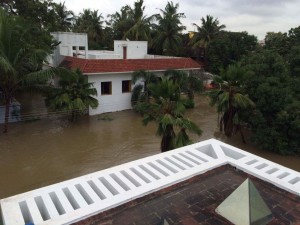
We learnt later that Chennai on Wednesday recorded the heaviest-ever rainfall in over a century — of 29.4 cm and 34.5 cm —the previous high being 26.1 in 1901. According to Skymet data, during the month of November, Chennai recorded a whopping 1218.6 mm of rain – three times its monthly rainfall. The normal rainfall figures for November stand at 407.4 mm.
All the reservoirs that cater to Chennai and its suburbs were empty before Diwali. By the end of November, water in the Chembarambakkam reservoir — one of the city’s main water sources — stood at 22 ft at this time, against its capacity of 24 ft.
On Dec 1st, enormous amounts of water were being released into the Adyar River as engineers feared a breach of Chembarambakkam’s boundary. It took three to four hours for the water to reach the city from the reservoir 25 km away, but by midnight on December 2, large areas of land around Adyar had gone completely under. Residents in these areas complain that they did not receive any prior warning about the release of this water.
The death toll at MIOT hospital stood at 18 because of lack of power and oxygen supplies. Newspapers reported that the final number of deaths just within Chennai’s metropolitan limits stood at 347.
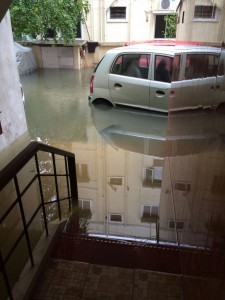
Military helicopters dropped food to residents stranded on rooftops and the defence ministry doubled the number of soldiers deployed to help with the rescue mission. Lakhs of people had been rescued, evacuated and accommodated in the make-shift relief centres. After being closed for an entire month, schools and universities were declared open again on 14th December. The airport which had been shut for 5 days resumed operations. By 17th December, the rain stopped and the waters began to recede.
Natural disasters have a way of bringing people together. They blur the lines of societal and political divisions for a brief period. In the aftermath of the floods, it was easy to see these lines slowly reforming again. Fingers were pointed in all directions. The people blamed the government, the government blamed encroachments, and everyone unitedly blamed climate change.
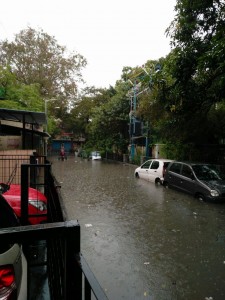
The flood impacted political, economic, educational and social aspects of the city. The government, eager to compensate for its inaction during the flood, responded by bulldozing several informal settlements. Multi-national companies released reports about the losses that their plants had suffered and considered moving their manufacturing bases to other cities. Schools and universities despaired over lost time and messed up calendars. Many areas faced erratic power supply for the weeks to come. The people of Chennai tried to cope with the stress of displacement and loss of their homes and valuables
The flood also sparked conversation about poor urban planning, lack of proper disaster mitigation programmes and the unpreparedness of the city to handle such situations. Personally, the flood led me to think about how we need a large-scale disaster to reflect about the fragility of the city in which we live. How can we justify poor urban planning by displacing millions of people who are the first to suffer and the last to receive compensation? How can we rationalize losses by simply shifting base to another location? How can we blame climate change on developed countries when we are active contributors to this phenomenon? The Chennai floods got a lot of people to think about their place in the city. I learnt that my world was hugely dependent on things I took for granted: electricity, internet and ironically, water. Despite us being in the midst of a flood, we had to use the water available to us sparingly. The floods also changed the way Chennai looks at rain. Never again will grey skies be a welcome anticipation of a ‘rain holiday’ because we know that somehow, somewhere, someone will face the same fate we all did as a result of the cyclone season.

